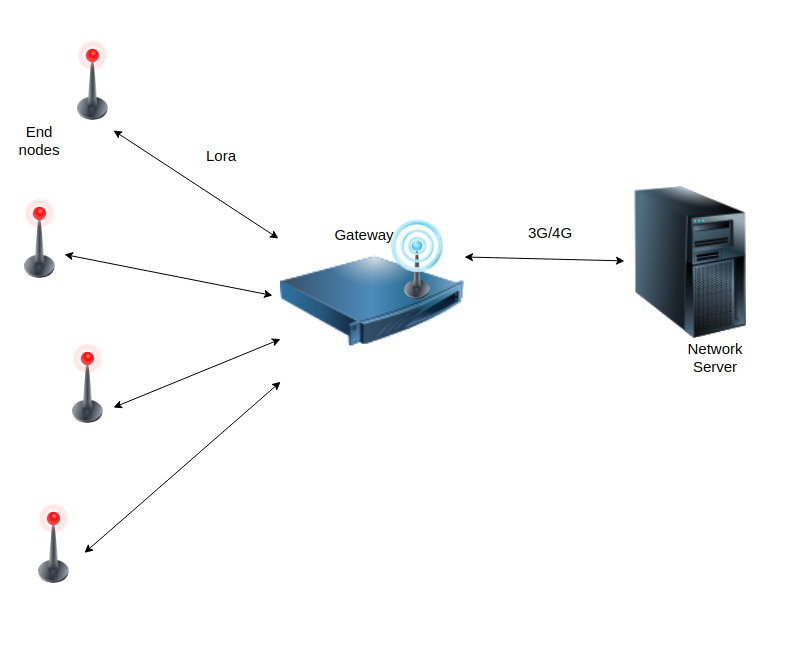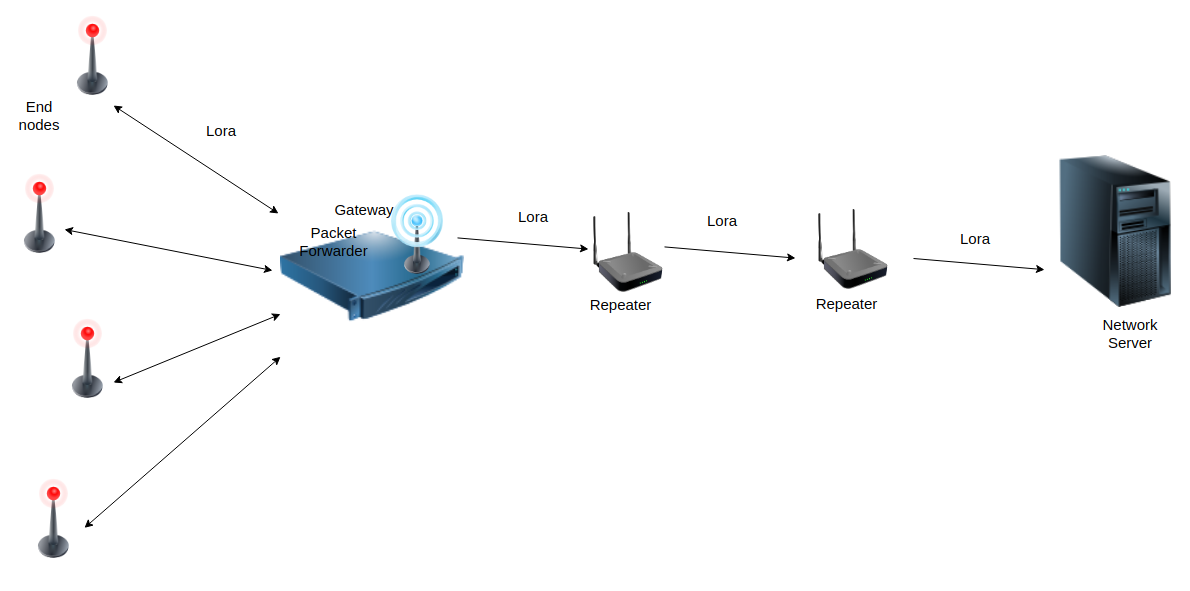-
Communication ideas (LoRaWAN)
05/21/2022 at 21:14 • 0 commentsI'd envisage we use the LoRaWAN protocol. The end nodes are only going to transmit small packets containing values from the sensors.
Transceivers
So we've got each detector (the end node) with an RFM9x LoRa packet radio at either 433 MHz or 868/915MHz. Important to note legality of using these frequencies in different countries!
Specs for RFM9x from AdaFruit:
- SX1276 LoRa® based module with SPI interface
- +5 to +20 dBm up to 100 mW Power Output Capability (power output selectable in software)
- ~100mA peak during +20dBm transmit, ~30mA during active radio listening.
- The RFM9x radios have a range of approx. 2 km line of sight with tuned uni-directional antennas. Depending on obstructions, frequency, antenna and power output, you will get lower ranges - especially if you are not line of sight.
e.g. RFM95w 868 or 915 MHz $19.95 + antenna connector SMA SMT etc. + actual antenna
Receivers
Then we've got a gateway to receive the packets from the end nodes. Something like the concentrator module iC880A 868MHz (https://www.thethingsnetwork.org/marketplace/product/lorawan-concentrator-868mhz) which is able to receive 8 packets simultaneously
[more details https://webshop.ideetron.nl/Files/3/1000/1211/Attachments/Product/g8VXtyg094107xP4XTa4Ot095y24E31j.pdf] alongside a host MCU. This could be a Raspberry Pi. Or a PC! And an antenna.
Topology
Star-of-Stars network topology for LoRaWAN https://www.researchgate.net/figure/The-LoRaWAN-network-topology_fig1_340100897
Well there isn't going to much fun regarding line of sight without obstructions in a forest between the end nodes and the gateways! Do we have the gateways mounted on tops of trees with directional antenna? So the gateways are just really packet-retransmitters now? This is going to take a bit of investigation!
General layout: gateways communicating with servers via 3G/4G
![]()
General layout: gateways are now also packet forwarders, with repeaters between them and servers.
![]()
So I found some ideas for using repeaters and making the gateway software do packet forwarding!
https://github.com/Lora-net/packet_forwarder/issues/80
https://github.com/Lora-net/picoGW_packet_forwarder
And idea for the repeaters is just this Challenger RP2040 LoRa (868MHz). It's the RPi RP2040 MCU + the LoRa RFM95W modem. See e.g. https://www.tomshardware.com/news/raspberry-pi-pico-challenger-rp2040-lora-revealed (~£22). Antenna via U.FL connector
There's an interesting rocket project using the RFM95W modem here https://johnjonesfour.com/2020/10/03/model-rocket-telemetry-part-1/ as a breakout for the RPi Zero. Presumably would be fun with a high-altitude balloon too!
Regulatory
Frequency plans by country https://www.thethingsnetwork.org/docs/lorawan/frequencies-by-country/
Regulation overview. Take note of duty cycle and maximum emitter power! https://www.disk91.com/2017/technology/sigfox/all-what-you-need-to-know-about-regulation-on-rf-868mhz-for-lpwan/
-
Sensors to consider!
05/18/2022 at 19:17 • 0 commentsTo note with these gas sensors: we'd want a fan to get good ambient air flow into the enclosure containing the sensors!
PM 2.5
Nova PM Sensor SDS011 (0.3 to 10μm) https://components101.com/sensors/nova-pm-sensor-sds011-pinout-features-working-applications-datasheet only rated 70% humidity | PRICE: approx £18 // some accuracy comparisons https://influencair.be/accuracy-of-the-sds011/
C02
First we want to know what level of C02 should we expect normally for baseline? Well sea level at 15 C and 101325 Pa [verify source!] we have 0.04% C02 in the air.
The EM500-CO2 CO2/Temp/Humidity/Pressure Sensor is popular for forest fire applications, however it costs around 250 euros! So that's no good!
These are all kinda expensive. We've got maybe the MG811 https://sandboxelectronics.com/?p=147 "gives an output in the range of 100-600mV (400—10000ppm CO2)" 400ppm being the baseline CO2 in air. Or perhaps MH-Z16 which is similar. These are in price range of $40-70
TEMPERATURE
Something like the DHT22 which can also do humidity https://tutorials-raspberrypi.com/raspberry-pi-measure-humidity-temperature-dht11-dht22/ | PRICE $3-4
GROUND MOISTURE
We've got something like the 'Gravity: Analog Capacitive Soil Moisture Sensor- Corrosion Resistant' sensor for around £6
https://wiki.dfrobot.com/Capacitive_Soil_Moisture_Sensor_SKU_SEN0193
MICROPHONES
I'm thinking of these or similar I2S MEMS Microphone for Raspberry Pi (INMP441) https://makersportal.com/shop/i2s-mems-microphone-for-raspberry-pi-inmp441 for around $8
CAMERA
Well if we do use a raspberry pi then we can use the standard camera 16MP fixed focus for £30 and do a detection of smoke or non-smoke images! Cost is around £30. An alternative is a thermal camera such as MLX90640 Thermal Camera (I2C) https://makersportal.com/shop/mlx90640-thermal-camera-for-raspberry-pi-32-x-24-pixels which sounds quite interesting. But we have a pricing of $90 and very small numbers available for supply.
CONCLUSION
Besides the camera, we seem to be looking at around $80 for sensors. The C02 sensors being most expensive, since these are electrochemical. However, there are some NDIR (nondispersive infrared) sensors that can be used. Although I envisage these to be more costly. The MH-Z16 is actually NDIR and slightly more costly. But we will need to further investigate these C02 sensors.
I'm not really feeling very hopeful to get to under $200 when we add an MCU + board and comms + power!
conscientious koala
Let's get an open-source sensor toolkit that can be used by communities to detect forest fires as early as possible!
 Neil K. Sheridan
Neil K. Sheridan
